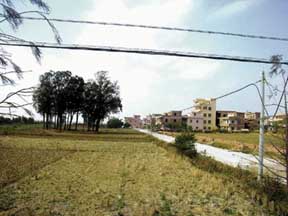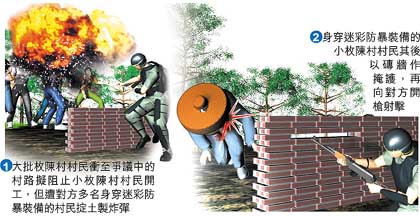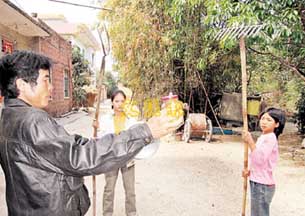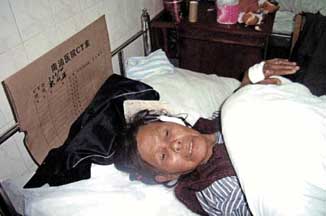The Zhanjiang Incident
This incident will probably be counted among the almost 100,000 mass incidents that have occurred or will occur in year 2006. In brief, more than 500 villagers were involved in a fight in which shots were fired and bombs were thrown. More than 20 people were injured, including two policemen (one of whom was the police station director). But this incident has a completely different flavor. The following description is combined from five different sources: Ming Pao, Apple Daily, Wen Wei Po, Oriental Daily and South China Morning Post. The sum total is richer in detail than any of the reports alone. Read on ...
The place is in Huangpo township, Wuchuan county, Zhanjiang city, Guangdong province. There are two villages known respectively as Dameichen village and Xiaomeichan village. The prefix 'Da' means large and about 2,000 people live in Dameichen village; the prefix 'Xiao' means small and about 800 people in Xiaomeichan village. Given that they have the same suffix, one would think that the villagers are good neighbors. But they are not, and they have been historically antagonistic. Previously, they had a long dispute over farmland. In late December, the city and town officials attempted to mediate unsuccessfully.
The cause of the pitched battle is a certain road to be built on the boundary between the two villages. Originally, the two villages had agreed to set up a common fund to construct a road that was about one meter wide (that is, it is a single-lane road). But Xiaomeichun decided unilaterally that the road would be 4 meters wide instead with a concrete top. The Dameichun villagers were concerned that their water source would be cut off and objected. Conversely, the Xiaomeichun villagers were also concerned that their water source would be cut off because Daimeichun wanted the road for itself.
At just about 9am on February 3, 2006, about 200 Xiaomeichen villagers began work on the road. Why on this day? Because according to the Chinese calendar, this was a good day to begin construction work and therefore they insisted on starting.
Here is the photo at the scene. You can see part of the road. Xiaomeichun village is in the background, and this is not exactly underdeveloped. The most important structure to note is that there is a long brick wall about 1.6 meters tall to the Xiaomeichun side of the road. It would come to figure prominently in the battle.

About 300 Dameichen villagers then gathered and marched to the construction area. They could see only about 200 Xiaomeichen villagers. The Dameichen villagers were led by women carrying hoes and pitchforks and were ready for an armed confrontation. But they were in fact being ambushed. Behind the brick wall were more than 40 Xiaomeichen villagers. These men were dressed in camouflage uniforms, they wore steel helmets and body armor, they had anti-riot shields, they had homemade rifles and they had an ample supply of homemade bombs.

When the Dameichen villagers got there, the ambushers suddenly sprung up. At certain places on the brick wall about 1.3 meters above ground level, there were openings from which the ambushers fired their rifles at the attackers. They also threw dozens of homemade bombs made from firepowder contained in glass jars that used to hold preserved bean curds (「 腐 乳 樽 土 製 炸 彈 」, see photo below). Oriental Daily says that the homemade bombs contained gunpowder as well as toxic pesticides, but that delivery mechanism for toxic substance does not make scientific sense.

According to 38-year-old Chen Ayong, she was holding a hoe and going with other female villagers to stop the construction, but the other side tossed homemade bombs at them and also shot at them. After she was hit by a bomb, her husband Mr. Liu helped her leave the danger zone. Mr. Liu said: "It was like a battlefield. They kept shooting and throwing hand grenades."
There were 24 people who were hospitalized due to injuries. More than 80% of them were women. The 10 most serious ones are being treated at the Navy Military Hospital, including an 60-something-year-old woman. The most serious injury was a woman who had more than 40 pellets between her navel and thigh.

Where was the government? During the battle, the Wuchun county party secretary Gao Yongyuan was at the scene, but the villagers completely ignored him and went on with the battle. The party secretary required police escort to get away from the scene. There were more than 20 police officers at the scene but they were numerically overpowered. The Huangpo town police station director was wounded in the head, and another police officer was injured in the leg.
Was this battle preventable by the government? According to Dameichen villagers, they had heard that Xiaomenchen had removed all children under 17 years away from the village. Mayor Liu of Dameichen village said that the 40 plus persons on the other side had weapon systems such as body armor, steel helmets and shields because someone in that village is a high-ranking public security officer. A Daimeichen villagers said: "The Xiaomeichen villagers stocked up on bombs and rifles for weeks. Some of our people saw them smuggling illegal firearms into the village. We reported this to the police, but they did nothing." Conversely, the Xiaomeichen villagers said that they were forced to defend themselves with homemade bombs because the other side sent a large group of bad people armed with iron pitchforks and hoes to attack them.
Retroactively, on the next day, the police entered into Xiaomeichen village; they searched and found at least 3 homemade guns, one box of homemade explosives and a cache of weapons; they demolished the brick wall by the road and detained 10 persons for interrogation. The police have patrol cars out in the two villages to prevent a recurrence. In Dameichen village, they have their own sentry guards at the village entrance and they employ lights at night to watch out for surprise raids.
In any other western media report, this is the time to add the statistics: there were 58,000 mass incidents in 2003, 74,000 in 2004 and 87,000 in 2005 and then discuss how these mass incidents may result in the falling apart of the government and the country. Given the nature of this particular mass incident, do you think that line fits?
... and here come the western media. The reference to the total number of "mass incidents" is highlighted in bold red.
(Los Angeles Times) 15 Injured in New China Land Clash. By Mark Magnier. February 6, 2006.
In the latest case of unrest afflicting the Chinese countryside, at least 15 people were wounded, some seriously, when a gun battle broke out in a land dispute between two villages in the southern province of Guangdong. Residents said tension that had been brewing for years intensified in the fall, when Xiaomeichen residents decided to build a road through neighboring Dameichen. Both are in Huangpo county.
Things came to a head Friday, when Dameichen residents tried to stop the project, reportedly prompting several people from rival Xiaomeichen to pose as policemen and shoot at them. A resident who asked not to be identified said at least 400 villagers were involved. Among the 15 wounded was a Huangpo policeman shot in the foot, he added. "It was a terrible fight," the man said. It was unknown how many of the wounded were from each town.
Several hundred policemen have been called in from the surrounding area to quell the violence. So far, no arrests have been made, the man said, in part because Xiaomeichen and its residents are politically linked to a retired, but still powerful, local Communist Party secretary.
Witnesses told the Hong Kong network Cable TV that injuries from shotguns and homemade bombs numbered at least 20.
China has seen growing unrest in recent years tied to corruption, illegal land seizures, a growing wealth gap and long-simmering disputes like this one that come to a head under new development pressures. Village feuds involving local clans are part of a tradition in Guangdong dating back centuries. While communism discouraged clan identification in the 1960s and '70s, experts say, a more open society has allowed the tradition to return in areas.
A 2001 study of the resurgence of southern clans by Li Huaxiang, a professor with nearby Zhanjiang Normal College, reported 1,300 clan fights between 1979 and 1987, and 39 in the first eight months of 2000. Chinese rural communities are often essentially one extended family, so a perceived slight from a rival village can inflame passions for years. Most Dameichen residents, for instance, carry the surname Liu, and residents said their bad blood with Xiaomeichen stretches back two decades.
There were 74,000 "mass incidents" in 2004 in China, up nearly 30% over 2003, according to the public security minister. In recent weeks, officials in Beijing have warned soldiers and paramilitary police to be vigilant against troublemakers and remain loyal to the Communist Party. A year ago, two neighboring Huangpo villages came to blows over another road project. The conflict was sparked when a resident was killed in a traffic incident that the residents of the victim's village believed was intentional. Three houses were reportedly torched, an ancestor-worship temple destroyed and 100 villagers wounded.